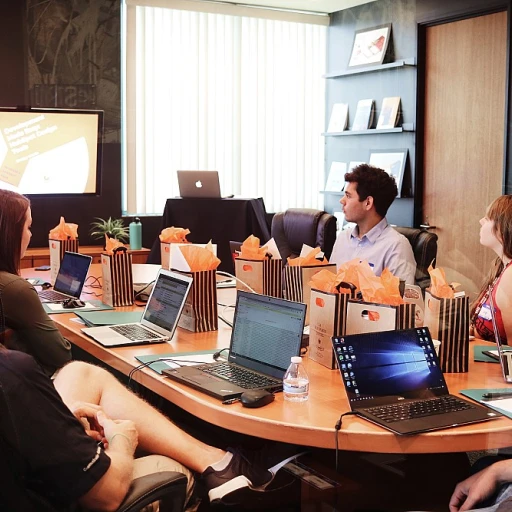
Understanding the Unique Challenges in Tech Hiring
Unique Obstacles in the Tech Hiring Realm
In the rapidly evolving tech industry, hiring new talents poses distinct challenges that set it apart from other sectors. Navigating through these complexities requires a keen understanding of both the technical skills and cultural dynamics needed to integrate a new team member successfully. Here are some of the key hurdles faced by companies:- Skill Gaps: The tech industry is notorious for rapid advancements, making it crucial to identify candidates with up-to-date knowledge and skills. A well-structured training program helps bridge these gaps, allowing employees to gain cutting-edge skills.
- Onboarding Complexities: The onboarding process in tech requires a deep dive into both technical and company-specific tools and workflows. To ensure employees are set up for success, it is crucial to implement an onboarding training process that is both detailed and flexible.
- Cultural Fit vs. Technical Expertise: Balancing technical skills with cultural fit is another unique challenge. Tech roles often require a harmonious blend of hard and soft skills, so companies must ensure employees align with the company's core values and team dynamics.
- Retention and Development: Offering continuous learning opportunities and creating a supportive environment can significantly improve retention rates. This is particularly important in tech, where career development becomes a crucial part of employee engagement.
Designing a Comprehensive Onboarding Program
Crafting a Robust Onboarding Program for New Tech Hires
An effective onboarding process is vital in acquainting new employees with their role and the company culture. A comprehensive program provides them with the skills knowledge essential to succeed in their new job. Here's how to ensure your strategy is as thorough and effective as possible:
- Define Clear Objectives: Your program should outline the specific skills and knowledge new hires must acquire. This entails understanding the core responsibilities of their role and the company’s expectations. It's beneficial to offer a blend of soft skills and technical training.
- Segment the Onboarding Plan: Break down the onboarding process into manageable phases. This approach steps new team members through the company culture, compliance training, and role-specific tasks incrementally, making the experience less overwhelming.
- Leverage Feedback: Ensure employees have opportunities to provide feedback about the onboarding training. This can guide continuous improvement of the training program and ensure the process remains relevant and effective.
- Use Varied Training Materials: Provide diverse materials to cater to different learning styles. Offer resources ranging from digital courses and webinars to hands-on workshops and manuals.
- Prioritize Interaction with Team Members: Encourage new hires to interact with fellow employees regularly. Incorporate activities and team projects early in the onboarding, fostering a sense of belonging and easing integration.
- Plan for Ongoing Support: After the formal onboarding period ends, ensure continuous support is available, promoting long-term learning and development.
The role of a job applicant in tech hiring must not be underestimated in structuring the onboarding plan, as their perspectives can offer meaningful insights into how to refine training programs. A successful onboarding plan not only prepares hires for their immediate tasks but also lays a foundation for their progression within the company.
Utilizing Technology for Training Efficiency
Leveraging Technological Tools for Streamlined Training
In today's fast-paced tech industry, utilizing technology for training efficiency is crucial. Implementing the right tech tools and resources can significantly enhance the onboarding and training experience for new hires. Companies looking to streamline their onboarding process should consider the following strategies:- Interactive Training Platforms: Digital training platforms offer interactive modules that can engage employees better than traditional methods. These platforms allow team members to learn at their own pace, which is particularly effective for acquiring new skills and solidifying existing knowledge.
- Virtual Reality (VR) and Augmented Reality (AR): VR and AR technologies provide immersive learning experiences that are invaluable for hands-on roles. These technologies can simulate real-world scenarios, offering employees a risk-free environment to practice and hone their skills.
- LMS Integration: A Learning Management System (LMS) can be the backbone of your training programs. It organizes training materials, tracks employee progress, and helps ensure compliance with company standards. This centralized approach makes it easier to update content, making the learning process more dynamic and responsive to feedback.
- Mobile Learning: Given the growing reliance on mobile devices, offering training through smartphones and tablets can further enhance accessibility. This flexibility allows employees to fit learning seamlessly into their schedules, whether they are commuting or taking a break.
- Automated Feedback Systems: Implementing systems that provide real-time feedback can help employees correct mistakes and improve their skills more quickly. Automated feedback tools can analyze performance data and suggest personalized learning paths for quicker skills development.
Mentorship and Peer Support Systems
Creating a Strong Foundation with Mentorship Programs
When it comes to hiring in tech, investing in mentorship and peer support systems can be a game-changer. New hires often face a steep learning curve, and integrating experienced team members into their training can effectively bridge this gap. Here's how mentorship can enhance the onboarding and employee training processes:- Peer Guidance: When new employees join, having a mentor who can guide them through the company culture, processes, and job-specific tasks makes the transition smoother. It builds a supportive environment where employees can seek practical insights and real-time feedback, crucial in enhancing their soft skills and overall job performance.
- Knowledge Sharing: Mentorship programs facilitate the sharing of skills and knowledge across team members. In fast-paced tech environments, this continuous exchange of information ensures that employees stay updated with best practices and latest industry trends. This collective learning boosts team cohesion and productivity.
- Support System: A well-placed mentor acts as a support system for new hires, reducing the time it takes for them to achieve full productivity. It also plays a pivotal role in building confidence, thereby accelerating their learning and adaptation processes.
- Feedback and Improvement: Mentors provide valuable feedback that helps employees pinpoint areas needing improvement. This personalized feedback loop accelerates learning and enhances their skills over time, ensuring a more effective training program.
Continuous Learning and Development Opportunities
Encouraging Lifelong Learning in the Workplace
In the fast-paced world of technology, companies must recognize that employee training is not a one-time event but a continuous process. It's essential to foster an environment where lifelong learning is embedded in the company culture. To achieve this, consider implementing the following strategies:- Regular Skill Assessments: Regularly evaluate your team members' skills to identify areas needing improvement. This practice helps determine the necessary training programs, thereby making the onboarding process more effective.
- Customized Training Plans: Utilize feedback from employees to tailor employee training programs that cater to individual needs. Customized programs are often more engaging and relevant, ensuring employees acquire the skills right for their roles.
- Promote a Growth Mindset: Encourage employees to adopt a growth mindset by promoting the belief that skills and knowledge can be developed through dedication and hard work. This mindset significantly benefits both the individual and the company.
- Offer Diverse Learning Opportunities: Combine various training materials and methods like e-learning, workshops, and seminars. These diverse programs allow employees to put new skills into practice, ensuring efficient onboarding training.












